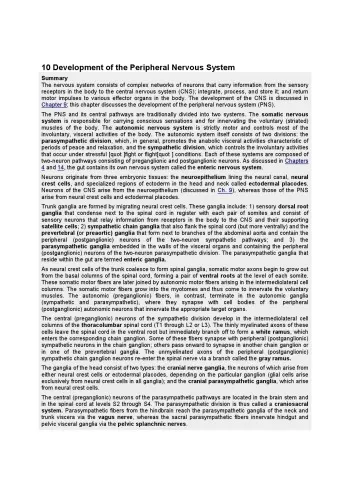Larsen's Human Embryology (chapter10: Development of the Peripheral Nervous System)
4.3
Reviews from our users

You Can Ask your questions from this book's AI after Login
Each download or ask from book AI costs 2 points. To earn more free points, please visit the Points Guide Page and complete some valuable actions.Related Refrences:
Introduction to Larsen's Human Embryology - Chapter 10: Development of the Peripheral Nervous System
Understanding the intricate processes that govern human development is crucial for both educators and students within the fields of medicine and biological sciences. "Larsen's Human Embryology" serves as an authoritative source, spanning a wide array of developmental stages and intricate biological processes. Chapter 10 specifically dives into the fascinating journey of the peripheral nervous system (PNS) during human embryological development.
Detailed Summary of the Book
This chapter meticulously outlines the ontogeny of the peripheral nervous system, beginning from its origins in the neural crest cells to its expansive network connecting the central nervous system to the limbs and organs. As one journey through this chapter, they are introduced to the migration patterns of neural crest cells, their differentiation into various derivatives, and the environmental influences guiding these processes.
Additionally, the chapter provides insights into molecular pathways and gene expressions that dictate PNS development. It elucidates the signaling mechanisms, such as the role of growth factors and cell adhesion molecules, that orchestrate cell migration and axon pathfinding. By presenting case studies and abnormalities, the text also emphasizes the clinical significance of early PNS development. This comprehensive approach not only elucidates normal developmental patterns but also educates on potential pathologies when this delicate system goes awry.
Key Takeaways
- The peripheral nervous system originates from neural crest cells, which are multipotent and highly migratory.
- Signaling pathways, including those mediated by growth factors like BMPs and WNTs, are crucial for the differentiation and migration of neural crest cells.
- Axon guidance and synaptic connections are guided by environmental cues that ensure proper communication with the central nervous system.
- Understanding the genetics and molecular biology of PNS development has significant implications for treating and diagnosing congenital disorders.
Famous Quotes from the Book
"The successful establishment of the peripheral nervous system is a testament to the intricate dance between genetic programming and environmental signaling."
"In the symphony of human embryology, the neural crest stands as a remarkable ensemble driving diversity and complexity."
Why This Book Matters
The developmental journey of the peripheral nervous system holds significant clinical and scientific relevance. For students and professionals alike, understanding PNS development through Larsen’s Human Embryology enables a robust comprehension of both normal and pathological states. The book serves as an essential resource that bridges the gap between descriptive embryology and practical clinical applications.
The detailed exploration of cell biology, genetics, and embryonic morphology fosters a deep understanding of how disruption in these processes can lead to congenital abnormalities. This knowledge is crucial not only for academic purposes but also for advancing medical research and improving patient care in neurology and developmental biology sectors.
Thus, Larsen's Human Embryology stands as a pivotal text, enriching learners with the knowledge necessary to appreciate the complexities of human development and its implications on health and disease.
Free Direct Download
You Can Download this book after Login
Accessing books through legal platforms and public libraries not only supports the rights of authors and publishers but also contributes to the sustainability of reading culture. Before downloading, please take a moment to consider these options.
Find this book on other platforms:
WorldCat helps you find books in libraries worldwide.
See ratings, reviews, and discussions on Goodreads.
Find and buy rare or used books on AbeBooks.
1472
بازدید4.3
امتیاز0
نظر98%
رضایتReviews:
4.3
Based on 0 users review
Questions & Answers
Ask questions about this book or help others by answering
No questions yet. Be the first to ask!














